

[What if you] “don’t want to choose between creating wealth and serving the public interest, but would rather embrace the challenge of creating community wealth to serve the public interest.”
—BILL SHORE, The Cathedral Within, 1999
Success Was Accidental;The Idea Was Not
By Danny Meyer
People always talk about how Shake Shack happened by accident. But it didn’t really. I had read Billy Shore’s book, The Cathedral Within, about the human desire to build something far bigger than ourselves, something that would outlive us. What he proposed was a new way to think about building broader community wealth through capitalism. And right from the beginning I saw the hot dog cart in a public park, and Shake Shack itself, as a “community wealth venture.”
We agreed to do the cart in Madison Square Park (MSP) in 2001, as part of a Public Art Fund project by the Thai artist Navin Rawanchaikul, called I  TAXI. The artist conceived a working hot dog cart to accompany giant taxi cabs on stilts. We decided it would be interesting to explore whether our idea of “enlightened hospitality” could work for something as simple as a hot dog cart. That’s why we served only Chicago-style and Taxi dogs, because if you give people a choice of eight toppings, hospitality dictates you’d have to remember their preferences! We promised to donate 100% of our profits to the Park, which was sort of easy since we lost money in years one and two.
TAXI. The artist conceived a working hot dog cart to accompany giant taxi cabs on stilts. We decided it would be interesting to explore whether our idea of “enlightened hospitality” could work for something as simple as a hot dog cart. That’s why we served only Chicago-style and Taxi dogs, because if you give people a choice of eight toppings, hospitality dictates you’d have to remember their preferences! We promised to donate 100% of our profits to the Park, which was sort of easy since we lost money in years one and two.
I’ve said we made $7,500 in year three. Actually, we didn’t. I was just so embarrassed that we’d lost money for three years, we chose to make a bigger contribution. After three summers of operating the hot dog cart, we collaborated with the City of New York, the Parks Department, and the Madison Square Park Conservancy to imagine and build a permanent kiosk.
The idea was we’d raise the money philanthropically; the Park would be the landlord, the kiosk would create a reason for people to use the park and thus keep it safe: community wealth. Today, we know the role Shake Shack had in developing the Madison Square Park neighborhood. There’s not a real estate proposal that goes out that doesn’t tout us as a neighbor. We’re proud that today the Park makes serious money from Shake Shack.

Danny celebrates the opening of the Shack in the Park, with hizzoner, Mayor Mike Bloomberg, 2004.

@beeblegum
“Who ever wrote the rule that fast food can’t be great food?”
—DANNY MEYER
The world of full-service fine dining is the world most of our leaders came from. They grew up with a certain level of sophistication. That’s the reason Shake Shack tastes different, looks different, and feels different. It’s an important distinction to make. If you look at the history of restaurant chains, they began with a business mentality and a financial skill set—a mechanical process for replication and scale. It’s almost impossible to retrofit a fine dining mindset into that skill set, but we’ve learned that it is possible to develop and inject that skill set into a pre-existing fine dining mentality.
Shake Shack became a petri dish for our company, Union Square Hospitality Group. It was a place for our people to experiment with how we might learn to scale our philosophy of enlightened hospitality.
What is “fine casual”? As I once said in a talk I gave at TEDxManhattan, no change has floored me more than the convergence of fine dining and casual dining. Fine casual means appropriating the cultural priorities that fine dining, at its best, believes in. It’s a whole new way of balancing the equation of quality, price, and time. With fine casual you get nearly all the quality: you’re willing to give up some of the niceties of service (no reservations, no servers, or tablecloths, or flowers), but you’ll get 100% of the same food we would source—the same excellent beef, the same fine chocolate. You’ll save about 80% of the money you’d spend, and about 60% of the time.
Right place, right time. When the permanent Shack in Madison Square Park opened in 2004, it was a watershed year for restaurants in New York City. Legendary French restaurants were closing fast, but the food world wasn’t going backward on quality; we wanted to go forward without pomp or frills. Daniel Boulud’s db Bistro had added super-gourmet burgers; Momofuku Noodle Bar opened that year with high culinary aspirations and no backs on their stools. Gastropubs like The Spotted Pig opened, and even we were experimenting with bringing refined cooking to bar dining with our new restaurant at MoMA, The Modern. Our world was ripe for a place like Shake Shack.
Burgers! People wondered why they never thought of doing a really great burger in the guise of a quick-serve restaurant (not that it’s particularly quick to wait in that line). We just got lucky. As the late Josh Ozersky wrote in Esquire: “Shake Shack took the ultimate American trash food and approached it not as an object for postmodern reinterpretation, but as a dish to be executed.”
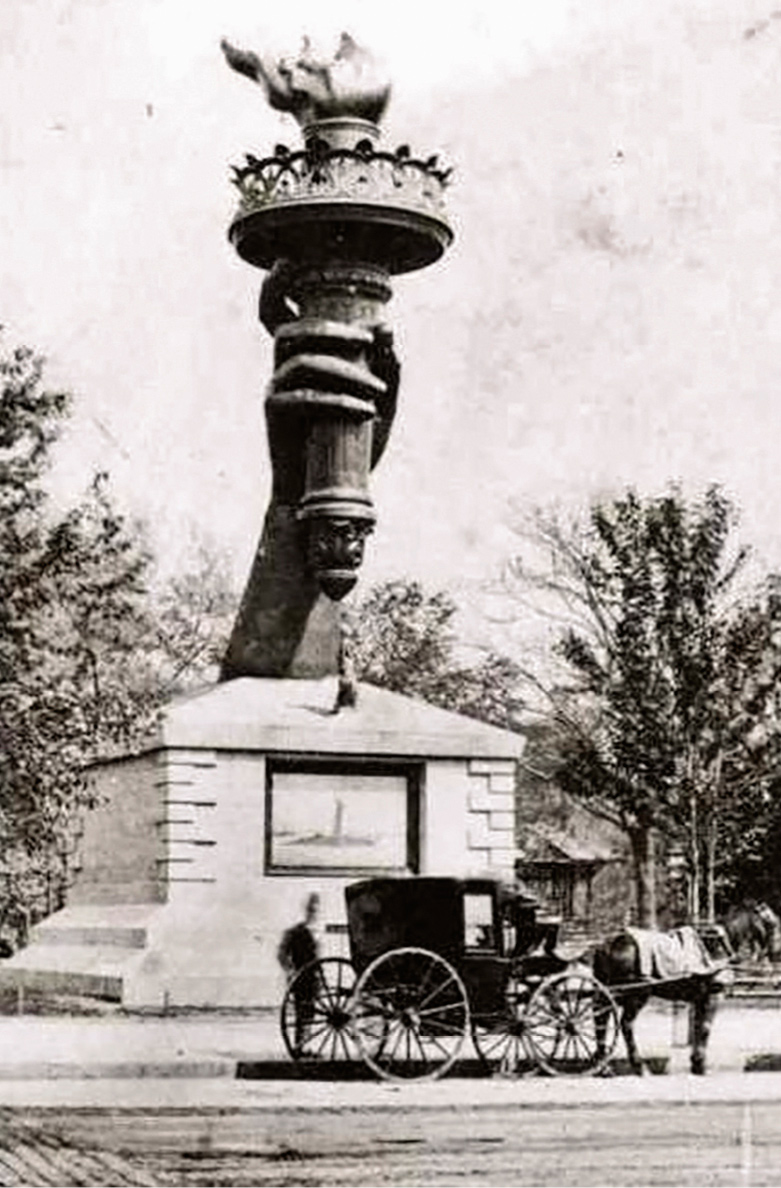

Since 1870, art was a part of Madison Square Park. The Statue of Liberty’s right arm, in 1876; I  TAXI sculpture by Nabin Rawanchaikul in 2001.
TAXI sculpture by Nabin Rawanchaikul in 2001.
The Original Menu Sketch

In 2003, Danny sketched his ideas for a permanent kiosk in the Park on the back of a piece of stationery. The eventual Shack is startlingly close to that vision.
Round Two was bigger than Round One. At USHG, we had never even thought of doing anything for the second time. Anything! People said “You’ve gotta do another one.” And I said “But we don’t DO other ones!” I was urging slow, slow, slow growth. I was the emergency brake. But the second Shake Shack on the Upper West Side that we opened in 2008 is a huge part of this story, because not only had we never done anything for a second time, but if that one had not succeeded, there would be no Shake Shack as we know it.
What can you do about the line? People may not realize the line is a result of cooking everything to order. At MSP there was nothing we could do about the line except open a second restaurant. And maybe I was the first restaurateur in history to be rooting for a little cannibalization. But it didn’t happen. When we opened on the Upper West Side, the line only got longer at the first Shack.
Places that make you happy. Shake Shack was emotional from the start. We were flirting with ideas like, wouldn’t it be fun to put Shake Shack at the top of a great ski mountain? Citi Field was Shake Shack 2.5. Our question at the Mets game was, did Shake Shack have the power to make you happy even if you were sad about the score? People were coming to the game up to two hours early to get in line at the Shack. That proved to us that people wanted to gather at a Shake Shack no matter where it is.

Devouring a ShackBurger at Citi Field.
A learning experience. With every single Shake Shack we opened in those days, we were trying to learn something, asking ourselves, what did we discover about Shake Shack that we never knew before? We wondered if the first one worked only because it was a freestanding building in a park. So, the first few Shake Shacks we opened were adjacent to green space—Upper West Side was across from the park at the Museum of Natural History; Upper East Side had that outdoor patio area (which was constantly under scaffolding).
A mirror of its community. I’ll never forget my feeling of joy when I visited the Shacks in Dubai and Kuwait. Seeing the exact same tray of food we served in New York carried by women in burqas, and those women photographing their food and posting on social media, just as folks did at home. Each Shack became a mirror of its place, because there’s nothing particularly imposing about the menu. No one has never heard of a hamburger.

 |
Steak ’n Shake St. Louis, MO Much about this 1934, Midwest-born burger chain inspired Shake Shack. Its motto, “In Sight It Must Be Right,” dances around the building like the Shack’s menu, and refers to its quality beef as well as its transparency to customers. |
 |
Fitz's St. Louis, MO One of Danny’s teenage faves, Fitz’s has since closed and reopened, still offering burgers and draft root beer using its original recipe of natural roots, bark, and spices. |
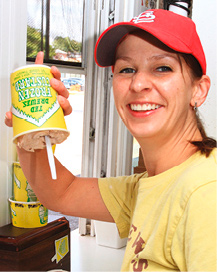 |
Ted Drewes St. Louis, MO A St. Louis icon since 1936, Ted Drewes pretty much invented the frozen custard Concrete, so-called because it’s so thick you can turn it upside down. |
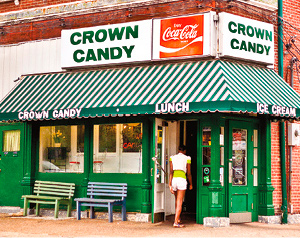 |
Crown Candy Kitchen St. Louis, MO This classic soda fountain opened in 1913, specializing in BLTs, milk shakes and malts. Crown continues to draw legions of fans and is a favorite of Danny’s. |
 |
Pie ’n Burger Pasadena, CA Since 1963, this California classic has made the kind of flattop griddle burgers Shake Shack loves, from fresh, quality beef and a signature sauce.  Favorites of Richard Coraine  |
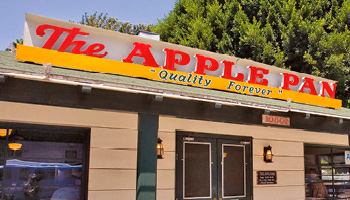 |
The Apple Pan Los Angeles, CA Made to order and griddled. LA Times food critic Jonathan Gold calls the Apple Pan burger (made since 1947) “one of LA’s greatest culinary legacies.” |


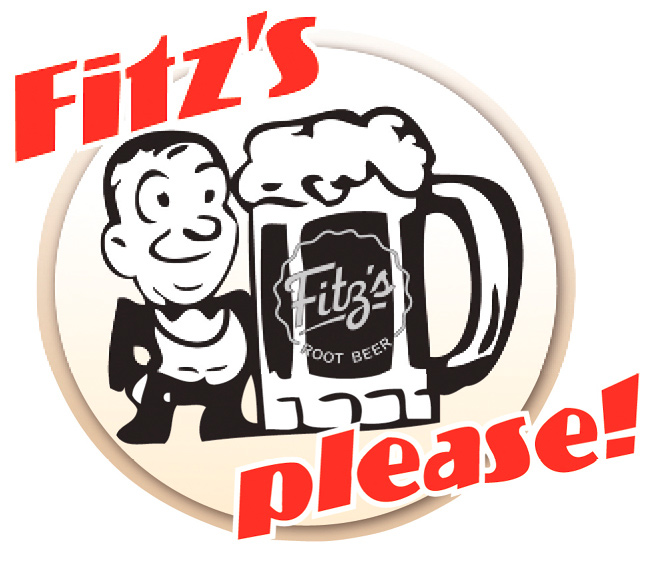
“I was 16 in St. Louis and I just got my driver’s license. That meant freedom. We could go anywhere! And anywhere was always the drive-in.”
—DANNY MEYER

Here’s how Danny Meyer remembers it: “One of the single best decisions I ever made was one day in 1999, I picked up a call from a restaurant owner from Seattle, who said, ‘You don’t know me but there’s a young guy, I know him really, really well. Just hire him.’ Turns out it was Chris Canlis, whose family owns Canlis, one of the best restaurants in Seattle. And Randy Garutti, who was general manager of Canlis, was the guy he wanted me to meet. That was about the most important job interview I ever had.
“Randy came to work for USHG as our youngest general manager. He was probably about 18! (Really 24!) He became general manager at two of our restaurants, Tabla (2000) and then Union Square Cafe (2003), and then (in 2004) he became Director of Operations for all of our fine dining restaurants which by then included Shake Shack. In 2007, just before we opened our momentous second Shack, we made him Chief Operating Officer. By the end of 2011, Randy became CEO of Shake Shack, and we’ve never looked back.”


“I just felt this big gravitational pull of this little thing in the park and all of its needs, and I just couldn’t let it go.”
—RICHARD CORAINE, CHIEF DEVELOPMENT OFFICER, USHG
Richard Coraine has a deep background in fine dining restaurant management and has been with Union Square Hospitality Group since 1996. Less known about RC is that in 2004, while he was COO of USHG, he became so obsessed with cooking burgers at the first Shack that his oldest friends didn’t hear from him for months; that he cooked in, for luck, the same greasy blue windbreaker; that he staffed the first Shack with ten kids from the then-worst high school in New York.
Many cultural myths surround the birth of Shake Shack, but RC takes it back to 1997, and a pivotal meeting with MetLife, who owned the building that would house the USHG restaurants Eleven Madison Park and Tabla: “The Met Life people asked us what we envisioned. Danny said, ‘Before we get to restaurants, I need to know your plan to develop Madison Square Park.’ This was the first meeting I’d ever attended with Danny and it immediately struck me that the park mattered more to him than any restaurant we’d do. The MetLife team had the right answer: ‘We plan to raise millions to redevelop that park, because we realize that’s as important as anything.’ ‘I want to be part of that initiative,’ Danny said. He told them we would not put restaurants here unless they faced, and (I remember him saying) ‘a world class park.’ His strategy was ‘if we could be part of the improvement of the neighborhood, be a leader on fundraising for the park, then maybe we could get the kiosk.’ He already had that idea!”

Road warrior Coraine, researching frozen custard at Ted Drewes in St. Louis, 2003.
Whatever we do in the park must satisfy three things, Danny said. “It has to be a magnet for the community, bringing people to the park. Any funds we earn must enrich the park. And it has to be fast, because people who come won’t stay long.”
Let’s talk frozen custard. “Danny sent me to find the best frozen custard in America. It had to be as good as Ted Drewes in St. Louis. I flew to St. Louis and went to Ted Drewes every day and stood in the parking lot, sketching their production. Then I set out across the country.”
“Our burger has to be great.” “Danny’s big on benchmarking. To figure out our burger, Danny sent me to Steak ’n Shake in the Midwest. ‘I want you to look at how they smash it, hold it down, flip it over and hold it down again.’ Our burger became the composite of many places: In-N-Out, where they make everything by hand and to order. I didn’t want to do their burger, but I studied their efficiency. Apple Pan’s made-to-order griddled burger that’s a favorite in LA. Danny was clear, it had to be made on a griddle. You can’t get that Steak ’n Shake mashed-down-on-hot-metal crust—on a grill. I’ve probably eaten 500 times at Pie ’N Burger in Pasadena, and in LA, Mo’ Better Meaty Meat Burger.”
My pivotal Shake Shack moment: “People kept saying: ‘You’re the COO of the company. Why are you out there making burgers?’ Randy was then my ops guy, my number two, doing all my work. We had his annual review at Eleven Madison Park and suddenly it came to me! I pointed to the Shack: ‘Why don’t you take that thing in the park and do something with it?’ He thought about it for about five seconds and said, ‘If you’ll give me autonomy, if you’ll let me have that as my business, I’ll do it.’ And I said ‘Yes.’”
He’s the guy who really had a vision. “Everything that exists today is Randy’s doing. He started showing up for meetings in his Shake Shack shirt smelling like burgers. Me? I went back on the road to find the next chef for Eleven Madison Park—Daniel Humm.”

The original Shack team; then–Eleven Madison Park chef Kerry Heffernan and pastry chef Nicole Kaplan, 2004. First Chicago dog, neon relish.

“We designed the Shack as a humorous commentary on commercial architecture, based on the unexpected juxtaposition of pop culture in a historic park.”
—JAMES WINES, FOUNDER, SITE
A bit ’50s roadside burger stand, a little bit menu-as-building sculpture, and a little bit rock and roll, the original Shack in the park was designed by James Wines and his architectural firm, SITE, famous for Wines’ imaginative fusing of art, architecture, and the environment. The designers spent weeks in that park to find their iconic solution, one that reflects the gray tone-on-tone patterns of the nearby Flatiron building. The resulting 20' × 20' building was the Shack heard ’round the world.
Denise MC Lee and her design partner, Sara Stracey, who met at SITE, went on to found Studio SSMC, and to design dozens more Shacks with a wide range of architectural distinction such as Boca Raton, Florida; Westbury, New York; and Austin’s Domain. “The original Shack created its own archetype,” says Denise. “We discovered how many different ways we could spin it around the world.”

Drawing by James Wines
LOCAL HERO

“I love that it worked! I love that they kept with it.”

They met in the Park: Pentagram’s famed graphic designer, Paula Scher, whose Fifth Avenue offices overlook it, and Danny Meyer, a Park board member, whose little kiosk was about to open. Debbie Landau, then head of the Madison Square Park Conservancy, wanted to ensure that the new kiosk graphics would work with the Paula-designed Park graphics.
“When I looked at that building by SITE, just dropped into the Park, I thought ‘moderne,’ and ‘streamlined.’ That’s why I chose the Neutra font for the Shake Shack logo. There was this beautiful metal beam that protruded from the building all around which became the perfect place to house the menu type.”
Four years later, before the second Shack opened on the Upper West Side, Danny, with Randy, returned to Paula to rethink the graphics. “We developed other takes on the graphic identity, some of which are pretty funny (see chart below),” Scher says. “But the really wise decision was to keep the Neutra logo. It was already recognized. The Shake Shack logo, the neon burger, and the script type became an easily recognized kit of parts that can and have been used in so many ways.”
The Opening Design
The red line through meant NOT your ordinary…

Other Ideas
Then we made lots of cow patterns in pretty colors.


The cows become playful, with food inside—a cow joke.

We tried one where everything shakes and dances.


Today!
The Neutra and the neon, the winning combination.
HOW SOCIAL MEDIA SHAPED US
“Shake Shack has an almost McLuhan-esque grasp of media.”
—JOSH OZERSKY, Esquire
“Most restaurants,” Ozersky explained, “when their small, cramped quarters can’t make enough food to feed their customers, register it as a disaster, issuing public apologies.…Shake Shack makes it part of their platform. That huge line of people snaking down the park…? They’re having a good time! The line is part of the Shake Shack experience!”
Randy has his own take on social media: “We understand that everything you do you have to share, now. And what does that mean? It forces you to make really good decisions and align yourself with brands whose ethos you share. One of the reasons we’re here is that people are proud to share Shake Shack. The iPhone came out in 2007, just before we opened our second Shack. Today, we have hundreds of thousands of followers on Instagram, people proud to post on Facebook and Twitter and Snapchat. You have to share pictures you’re proud of. What that means is you might even decide to go to Shake Shack because you know you want to share. Sure, it’s your desire to have great food, but it’s also your desire to be seen having that food with the people in your life who matter. Social media has intensified our need to be associated with the brands we love.”

@whitneytravels


Illustration by Peter Arkle